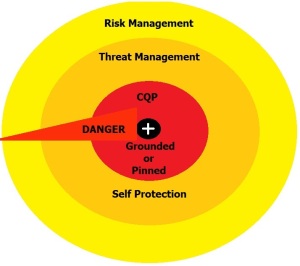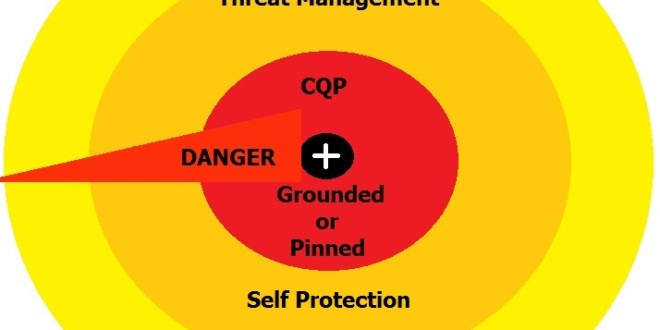I’ve always prided myself on my self-defence syllabus and its content and how it has developed over the years. The content has always been there but I’ve always struggled with what content to put where and what terminology to use to get my point understood correctly without getting too complicated. Its ok knowing what you want to teach but getting someone else to understand it is vital to show a good system. So keeping my system simple and logical has always been key for me. I’ve trained with some brilliant people over the years in many systems and arts and I’m grateful for the knowledge they have shared with me and their input to my system. I’ve taken what I think works and put it into a system that I think is logical and effective. So I started with creating self-protection circles moving outside in with the danger increasing the closer you get to the centre of the circle and the circles represent proximity to you with my number 1 objective being getting home safe.

So what’s the best way to manage a confrontation or threat to get home safe? The answer is not being there in the first place. This is called risk management and if you do this correctly you should never be in a threatening situation. So the first part of my system is around how to manage yourself and how you behave to reduce the risk of this happening and spotting potential threats and being properly prepared if you have no choice but to deal with a threat.
But if you are there, what then? The answer is get out of there as quickly as possible this could be as simple as walking away. Remember your objective is to get home safe nothing else. If you can’t get out of there then what? The answer is to do whatever you need to get home safe. This will mean matching the level of the threat to get home safely this is called threat management.
So the second part of my system deals with managing the threat in a self-protection environment this means at a specific range to the threat and if done correctly reduces the level of danger to you. This part of the system is designed to be simple and easily remember with no complicated techniques instead you use certain skill sets to protect you from the threat. Responding to their threat to take control of the situation and attacking back appropriately. Hence R.A.T.C.A.B was born and works for both risk and threat management and stands for REMOVE ATTACK, TAKE CONTROL and ATTACK BACK.
Let’s start with Remove attack. (Skills)
Risk management (mind set) – Rule 1 Don’t be there. Using your skills to reduce the chances of a threat happening
Threat Management (physical action) – Move offline to remove attack if not redirecting or reduce the attacks effect using the skills taught to you.
Take Control – (Knowledge, Ability)
Risk management (mind set) – Having the knowledge and ability to recognise different situation and adapt accordingly. Hence taking control of your situation
Threat management (physical action) – Use familiar control points and knowledge learnt to maximise your strengths and having the physical ability to do so
Attack Back – (Intent)
Risk management (mind set) – Intent on not being a victim
Threat Management (physical action) – Having the intent to overcome the threat and doing what is necessary to get home safe
If one of the above is missing then the system won’t work and in my opinion intent is the most import as the rest can be learnt or gained through training. Intent is harder to gain as it’s more natural to who you are and your mind set.
As you move further in to the self-protect circle you move to CQP which stands for close quarters protection some system call this close quarters combat but I use CQP as I don’t want to give off the impression that I have anything to do with the military as I’ve had no military training what so ever and want people to take my system for what it is and that’s my interpretation of what I think works and judge me on that.
After CQP you move to being grounded or pinned
If you are at either of these stages then something as gone terribly wrong. You’ve not managed your risks or threat correctly to stop it progressing to the next stage. This could be down to a number of reasons. This is why my system is now taught in the order it is. Instead of incorporating ground work and close quarters at the beginning as I don’t want my students to default to these modes when under duress as these are more dangerous situations to be in and if can be dealt with in a self-protect scenario would be much safer.
The CQP section of my system is only taught to students that show they are competent at risk management and self-protection. This section teaches close quarter striking along with standing grappling drills to maintain skill levels along with locking and off balancing principles to gain the upper hand with a more detailed approach to control points and weapon control.
The grounded or pinned section focuses on gaining positional advantage as quickly as possible and is taught after the CQP section or sometime in conjunction with.
The last section to be taught is weapons (defence against and use of improvised weapons) and when it comes to the defence against weapons it’s a bit more of a formality as the self-protect section, CQP and grounded sections are taught as if the attacker has a weapon on them. This section is to reemphasise the importance of the fundamentals and psychological effects when a weapon is involved.
The improvised weapon section shows how to use everyday items in a self-protection scenario and how to take advantage of whatever extra potential that weapon gives you. Including use of scarf’s, belts, pens, torches, newspaper, umbrellas, walking sticks ect in place of tradition weapons. These are everyday items that people have access to and can be used effectively for self-protection. There’s no point me teaching someone how to use Nun Chaka’s to defend themselves unless they are going to carry them around with them 24/7 which is both illegal and impractical (plus I don’t know the first thing about using them I’m just using them as an example).
 JLD Fitness Personal Training, Romford, Self defence, Martial Arts, MMA
JLD Fitness Personal Training, Romford, Self defence, Martial Arts, MMA




